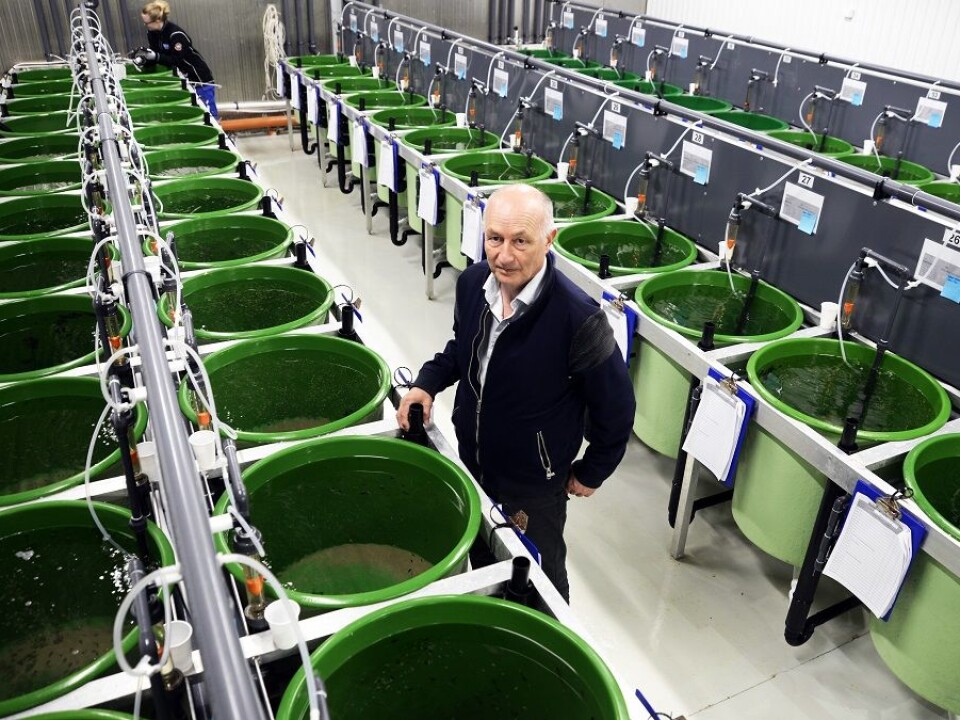This article was produced and financed by Nofima The Norwegian Institute of Food, Fisheries and Aquaculture Research

Breeding gluttons in the battle against salmon lice
Scientists have started to breed fish which have a special liking for consuming salmon lice. The preference for salmon lice seems to be a genetic trait.
The lumpsucker is a type of lumpfish. It uses its pelvic fins as suction discs, which it uses to attach itself to other objects. However, scientists at Nofima have another reason for taking an interest in this species. The fish can actually be used in fish farming, because they have an apetite for salmon lice, a common parasite pestering farmed salmon.
"Louse eating is the sole reason that lumpsuckers are of interest to us, but not all lumpsuckers are equally keen on this diet. Currently, there is a great deal of uncertainty about the proportion of them that will eat lice. Some estimate 30-40 per cent, others believe that well over 50 per cent have this trait," says Atle Mortensen, who is heading up Nofima’s research on lumpsuckers.
Last year, Akvaplan-niva, a research-based company, was allowed access to nine different lumpsucker families that Nofima had produced at its Centre for Marine Aquaculture in Kraknes in Tromsø. These were set out in salmon cages at Gildeskål Research Station (GIFAS) plant at Helgeland.
A super family
"Akvaplan-niva found that, of these nine families, there was one that stood out very strongly when it came to eating lice, while other families did not eat lice at all. They preferred the pellet feed that the salmon got," explains Mortensen.

Because of this, Nofima took siblings from the keenest lice eating family and used them as brood stock for some new lumpsucker families. The scientists have also produced some families based on families that did not eat lice.
All in all, Nofima now has 63 families that will be used to check out these findings on a larger scale. As soon as the lumpsuckers are big enough they will be put out in salmon cages in order to test their lice eating abilities under conditions that are as close to authentic as possible.
"Last year’s testing was the only case where we have known the family of the lumpsuckers that will eat lice. At the moment we have access to very little material, but the results indicate that eating lice might be hereditary," says Mortensen.
Breeding in mind from the very beginning
The material Nofima has on hand is unique.

"We are the first to have produced our own lumpsucker families from brood stock. Nofima had breeding in mind from day one, and we now have full control of the pedigree of this fish, says the scientist. The project has been going on for almost three years. Initially, Nofima concentrated on optimising the production of lumpsuckers."
"Now, we are so good at this that we can concentrate more on applications. First, we want to find methods that make it easier for us to quantify how many lice the individual lumpsucker eats."
"Are there significant variations?"
"Yes, lumpsuckers obviously don’t view eating salmon lice as foraging; perhaps they define it more as snacks that they like the taste of or that they think is fun to eat. Some eat only two or three, while others may have more than fifty lice in their stomachs."
Natural relationship
Mortensen is very familiar with salmon fishing, and says that lumpsuckers and salmon also have a type of symbiosis in the wild.
"Most of us who have fished with salmon nets have experienced lumpsuckers being caught together with the salmon. We still don’t know if this is due to coincidences or if the two species benefit from each other."
According to Mortensen, lumpsuckers are not particularly picky when it comes to food. They adhere to anything, and they eat whatever they might find. In the cages, some of them specialise in eating salmon lice, some prefer the feed that is given to the salmon, or they eat whatever they can find. They don’t swim very much and suck onto anything, even each other.
Scientists are fascinated by this small, almost spherical creature.
"It behaves very differently from salmon, which mostly just swim in circles and do not respond to anything other than the sound of feeding pipes. Lumpsuckers, on the other hand, are curious and come to greet you. They investigate their surroundings and are keen to explore new things."
Lumpsuckers also have another trait that can be useful to breed. The fish attract bacterial diseases. These tests are still in an early stage, but everything suggests that one can breed lumpsucker families that are more resistant to disease. If this can be combined with lice eating, the research being carried can prove to be very valuable to the salmon industry.






























